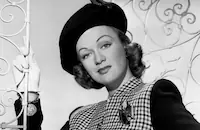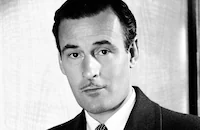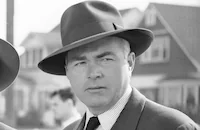One Touch of Venus
Brief Synopsis
Cast & Crew
William A. Seiter
Robert Walker
Ava Gardner
Dick Haymes
Eve Arden
Olga San Juan
Film Details
Technical Specs

Synopsis
Department store owner and playboy Whitfield Savory II buys a $200,000 statue of Venus, the Goddess of Love, which he plans to display in his store's art gallery. Intrigued by the statue's alluring beauty, Eddie Hatch, a lowly window dresser, kisses the statue and it comes to life. With the marble statue now missing, Whitfield accuses the window trimmer of stealing it. Eddie tries to tell Whitfield, Molly Stewart, Whitfield's long-suffering secretary, and Kerrigan, a private detective, how the statue came to life, but no one believes him. With no evidence against him, however, Eddie is sent home under the care of Gloria, his girl friend, and Joe Grant, his best friend and roommate. While Gloria and Joe are out getting Eddie some dinner, Venus arrives at the apartment and Eddie is forced to hide her from both Gloria and Mrs. Gogarty, his landlady. Later that night, Eddie sneaks Venus back into the department store and the two spend a romantic evening in the store's model home. Meanwhile, back at the apartment, Joe is inspired by Venus' song of love that floats through the air and proclaims his love to Gloria, then kisses her. The next morning, Venus is found asleep in the model home. Thinking that she is merely a beautiful young woman without a place to stay, Whitfield falls madly in love with her, but she rejects him for Eddie. Later, Venus offers to return to her pedestal, but Eddie, not wanting to go back to his old life, instead takes her out for an amorous night in the park. Their date is interrupted, however, when Eddie is arrested by Kerrigan and his men. With Eddie in jail, Venus goes to Whitfield's apartment, in hopes of convincing him to drop the charges. His interest in seducing Venus plummets, however, when a fed-up Molly threatens to quit. Eddie is released from jail, but as he rushes back to the store, Venus is called back to Olympus by Jupiter and returned to her marble state. The next morning, the statue is unveiled as Whitfield and Molly publicly announce their marriage. Eddie is depressed to have lost his love, but forgets about the statue when he meets a new salesgirl named Venus Jones.

Director

William A. Seiter
Cast

Robert Walker

Ava Gardner

Dick Haymes

Eve Arden

Olga San Juan

Tom Conway

James Flavin
Sara Allgood

Arthur O'connell
Kenneth Patterson

Ann Nagel

Russ Conway
Jerry Marlowe
Joan Miller
Charles Sherlock
Ralph Brooks
Mary Benoit
Josephine Whittell
George J. Lewis
Eddie Parker
Pat Parrish
Yvette Reynard
John Valentine
Frances Mack
Dick Gordon
Martha Montgomery
Jack Davidson
Phil Garris
Ralph Peters

George Meeker
Pat Shade
Bob Mccord
Helen Francell
Harriet Bennett
Joel Friend
Crew
Leo Arnaud
John Beck
Leslie I. Carey
Lester Cowan
Lester Cowan
Billy Daniels
Carmen Dirigo
Al Fields
Russell A. Gausman
Bernard Herzbrun
William Holland
David S. Horsley
Harry Kurnitz
Joe Lapis
Otto Ludwig
Ogden Nash
Emrich Nicholson
Orry Kelly
Frank Planer
Ann Ronell
Ann Ronell
William A. Seiter
Frank Tashlin
Kurt Weill
Bud Westmore
Eileen Wilson

Film Details
Technical Specs

Quotes
She reminds me of someone.- Whitfield Savory
I wish she reminded me of me.- Molly Grant
Trivia
Mary Pickford bought the screen rights to the original Broadway musical comedy for $150,000, intending to film the play with the original cast, which included Mary Martin. But the plan was abandoned when Martin became pregnant.
The original musical play opened in New York in October 1943.
Notes
While the onscreen credits list James Flavin's character as "Kerrigan," many contemporary reviews referred to his role as "Corrigan." According to news items, in September 1944, producer-actress Mary Pickford purchased the screen rights to the Perelman-Nash-Weill musical comedy for $150,000.. At that time, Pickford had hoped to film the play with its original cast, including star Mary Martin, using Agnes DeMille's ballets, but this plan was abandoned due to Martin's pregnancy. Producer Sam Coslow then was brought in and worked on the project for approximately eight months. In March 1945, Gregory LaCava filed a $1,653,750 suit against Pickford, arguing that she had backed out of an agreement to let him produce and direct One Touch of Venus. According to Hollywood Reporter, LaCava's suit was dismissed in July 1948.
In the summer of 1946, Pickford and Lester Cowan joined forces to create Artists Alliance, Inc., and One Touch of Venus become one of the principal properties of the new company. Hollywood Reporter news items report that Pickford and Cowan had planned to make One Touch of Venus in 1947 as a Technicolor production with a budget of $2,500,000, with screenwriter Henry Kurnitz working as both producer and writer. According to Los Angeles Times news items, Cowan had sought the famous Broadway husband-and-wife acting team of Alfred Lunt and Lynn Fontanne to play the gods "Jupiter" and "Juno" in the production, roles that were not in the released film.
After numerous delays, the film was readied for production in December 1947 as a Universal release, with filming set to begin in mid-January 1948 under the direction of Irving Reis. According to Hollywood Reporter, the production was delayed once more due to continuing casting problems. In January 1948, M-G-M agreed to loan actors Robert Walker and Ava Gardner for the lead rolls, and the film returned to Universal's production schedule. At that time, Reis was replaced as director by William A. Seiter. Hollywood Reporter news items state that Maury Gertsman was set to be the film's director of photography, though that assignment was later given to Frank Planer. Hollywood Reporter news items also state that the producers sought a "top radio comic for an important role," but were turned down by Milton Berle, Kay Kyser and Danny Thomas. Hollywood Reporter and New York Times news items also indicate that Hugh Herbert was cast as "Mercury," but his performance was cut from the released film.
According to a November 3, 1953 article in Hollywood Reporter, One Touch of Venus was among ten independent productions released by Universal that were foreclosed on by the Bank of America. In 1957, Daily Variety reported that Sunset Securities gained control of the film, having signed an agreement with Loew's Inc. stating that Robert Walker (who died in 1951) would be advertised as the film's star wherever the film was shown, and that images of Walker and Gardner from the film could not be used for any commercial reason other than advertising the film. One Touch of Venus was Walker's last screen appearance until the 1950 M-G-M film Please Believe Me (see below). According to December 1948 articles in Los Angeles Daily News, Walker was arrested in Topeka, KS in early December on charges of drunkenness and subsequently suffered a nervous breakdown. He was then committed to the Menninger Psychiatric Clinic in Topeka and released in early May after a six-month stay, according to a May 1949 Los Angeles Examiner news item.
In August 1955, the NBC television network broadcast an adaptation of the musical play, starring Janet Blair and Russell Nye, and directed by George Schaefer. Films with storylines similar to One Touch of Venus include Mannequin, a 1987 release starring Andrew McCarthy and Kim Cattrall, and directed by Michael Gottlieb; its 1991 sequel, Mannequin Two: On the Move, starring Kristy Swanson and William Ragsdale, and directed by Stewart Raffill; and the 1988 NBC television film Goddess of Love, starring Vanna White and David Naughton, and directed by Jim Drake.












